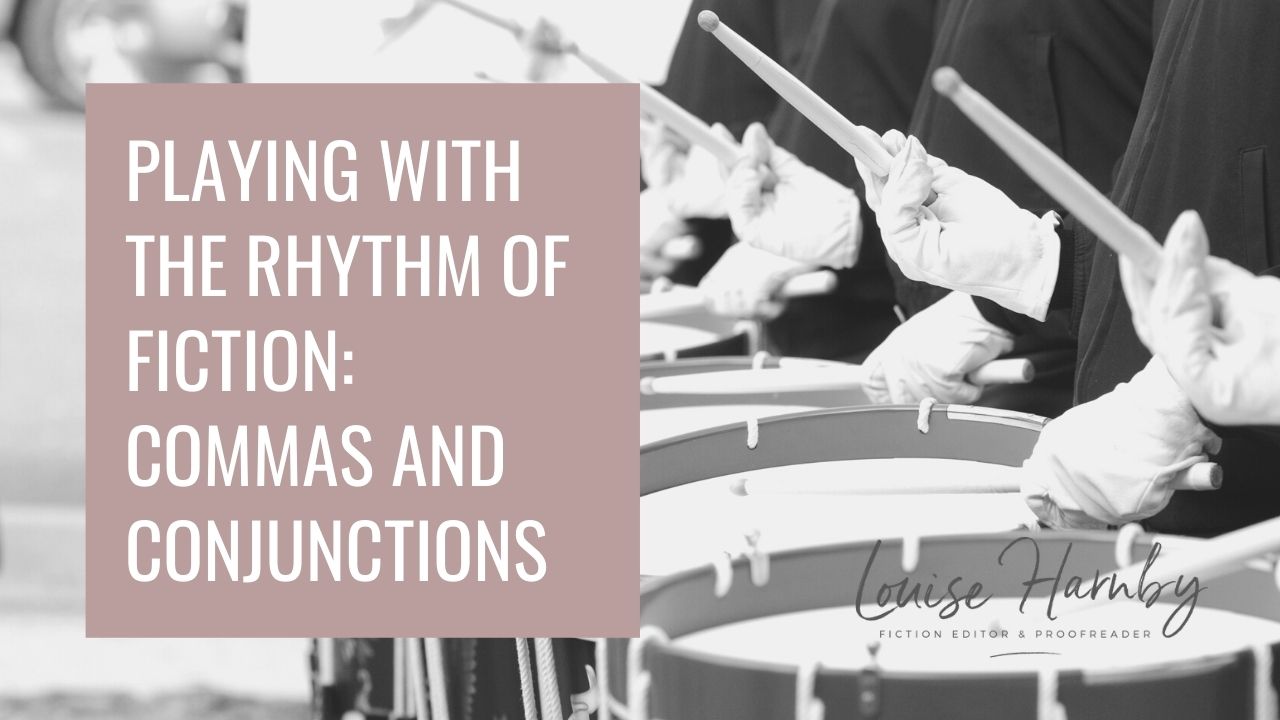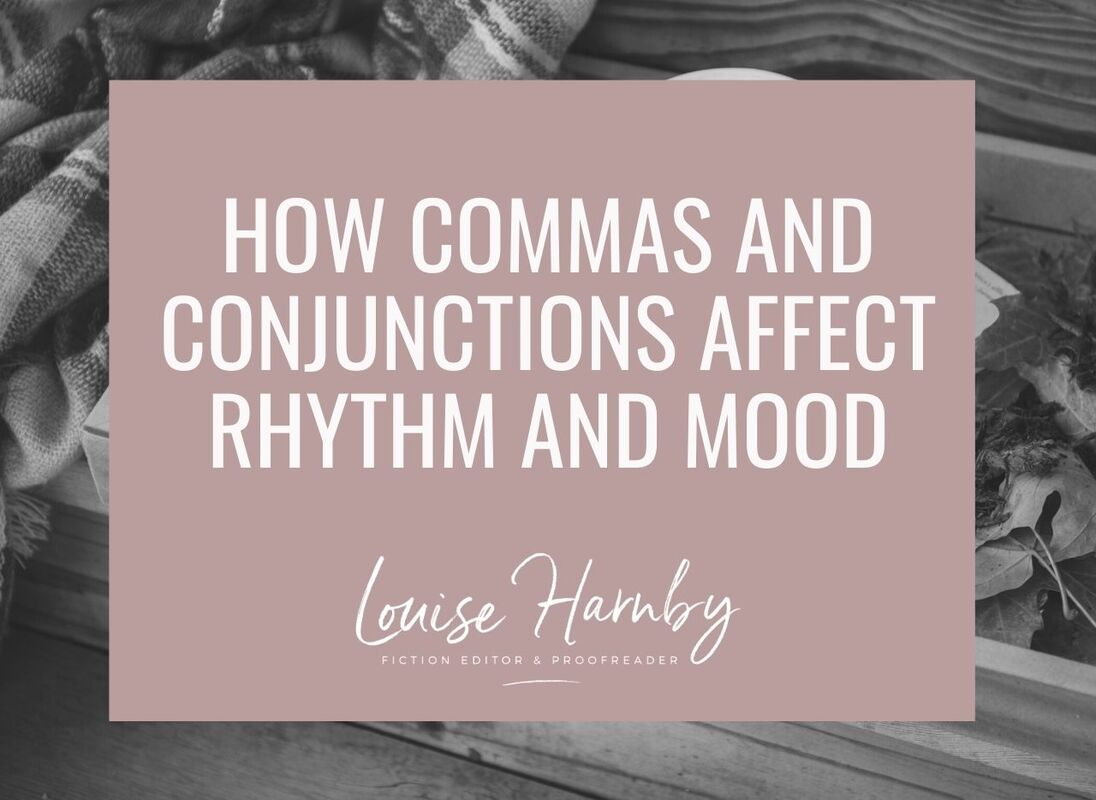|
This post shows you how you can use commas and conjunctions to alter the rhythm of a sentence. Changing the rhythm can help your readers immerse themselves deeper in the mood of your narrative and the emotions of your characters.
Standard grammar advice – the stuff we learned when we were kids – calls for lists with three or more items (or phrases or clauses) in a sentence to be separated by a comma, and for a conjunction to be inserted before the final item:
Her arsenal of weapons included rifles, pistols and machetes. Or, if your preference is to use the serial (or Oxford comma): Her arsenal of weapons included rifles, pistols, and machetes. The use of this one conjunction is called syndeton, and it moderates the pace. When it comes to fiction, standard grammar works very well for the most part. However, there are other accepted literary devices you can use to help your readers feel the scene you’ve written in a different way: asyndeton and polysyndeton. I’ve used examples from crime fiction in this article but the principles apply across genres. More on syndetic constructions Syndeton is everywhere. It’s the most oft-used way of constructing a sentence with multiple clauses, and it works well because it aids clarity: this thing, that thing and that other thing. Here’s an excerpt from At Risk by Stella Rimington (p. 369): And here’s an example from Jo Nesbo’s first Harry Hole thriller, The Bat (p. 250): This second excerpt is taken from a chapter in which the head of the crime squad, Neil McCormack, delivers a long speech to the protagonist, Harry Hole. Harry has just spent nearly an hour delivering his own monologue, updating McCormack on everything that’s happened so far. The mood of the entire scene is one of contemplation and resignation. The characters give each other the space to talk without rushing. Their behaviour feels controlled, and the way they talk is measured. The grammatical structure of the sentence (syndetic) is a good choice because it moderates the speed at which we read, and reflects the mood. Omitting conjunctions – asyndeton Authors might choose on occasion to change the mood of a sentence by deliberately removing the conjunction. Separating all the items with only commas accelerates the rhythm. That speeding-up can have a variety of effects:
Let’s go back to the Nesbo example and see what happens when we change it: ‘They helped the Allies against the Germans and the Italians, the South Koreans against the North Koreans, the Americans against the Japanese and the North Vietnamese.’ By omitting the conjunction and inserting a comma, a sense of frustration and urgency is introduced. It’s subtle, certainly, but that’s the beauty of it. If Nesbo had wanted to convey more immediacy, he could have elected to make these small changes. They would have altered the rhythm and showed (without spelling it out) that McCormack’s tone had changed or the pace of his speech had increased. Here are two examples from Robert Ludlum’s The Janson Directive (p. 274 and p. 355): In the example above, Ludlum could have introduced ‘and’ after/instead of the final comma of the first sentence with no detrimental effects, but I think its omission brings a sense of urgency and determination to the writing that reflects the tension of the scene. In the excerpt below, he uses asyndeton to evoke a sense of futility, frustration and anger. The reader is forced to become bogged down in the senseless loss of life from a bullet to the head:
‘Another dumb, inanimate slug would shatter another skull, and another life would be stricken, erased, turned into the putrid animal matter from which it had been constituted.’
Asyndetic constructions can be particularly effective in noir and hardboiled crime fiction. These genres don’t shy away from the dark underbelly of their settings. The characters are often as damaged as the gritty environments they work within, and a sense of hollowness and futility underpins the novels. Here’s an excerpt from The Little Sister (p. 177) by the king of hardboiled, Raymond Chandler: Imagine that second sentence with ‘and’ after (or instead of) the final comma. It would ruin the flow and remove the utter sense of despair and hopelessness. Chandler doesn’t overdo it though. He saves his use of the asyndetic for the right moments rather than littering his pages with it. Using multiple conjunctions – polysyndeton Another technique for altering rhythm is that of using multiple conjunctions. Polysyndetic constructions are interesting in that they can work both ways:
In the following example, Chandler (p. 103) shows us two different groups of people waiting in a reception area that the main character, Philip Marlowe, has entered. By using a conjunction between each adjective describing the hopefuls, he enhances the brightness of their mood. This in turn tells us more than Chandler gives us in terms of words about the other group. We can imagine their boredom and frustration:
‘There was a flowered carpet, and a lot of people waiting to see Mr Sheridan Ballou. Some of them were bright and cheerful and full of hope. Some looked as if they had been there for days.’
There’s a powerful example of the polysyndetic in Kate Hamer’s The Girl in the Red Coat (p. 151). Hamer uses it to enrich a child-character’s voice. Carmel has been abducted and is experiencing a kind of dislocation as she plays with two other children. The multiple conjunctions serve to emphasize the overwhelming giddiness. There’s almost no time to take a breath: Beware the comma splice Asyndeton should not be confused with the comma splice. A comma splice describes two independent clauses joined by a comma rather than a conjunction or an alternative punctuation mark. I recommend you avoid it because some readers will think it's an error and might leave negative reviews. The standard-punctuation column in the table below shows how the authors have got it just right. The right-hand column shows you how the non-standard comma-spliced versions would appear.
I hope this overview of syndeton, asyndeton, polysyndeton and the comma splice will help you to discover new ways of playing with the rhythm of your own writing while keeping the punctuation pedants at bay!
Resources and works cited
Louise Harnby is a line editor, copyeditor and proofreader who specializes in working with independent authors of commercial fiction, particularly crime, thriller and mystery writers. She is an Advanced Professional Member of the Society for Editors and Proofreaders (SfEP), a member of ACES, and a Partner Member of The Alliance of Independent Authors (ALLi).
Visit her business website at Louise Harnby | Proofreader & Copyeditor, say hello on Twitter at @LouiseHarnby, or connect via Facebook and LinkedIn.
8 Comments
12/8/2018 10:52:57 am
Thanks, Louise for this interesting post with its helpful information. :) --- Suzanne
Reply
Louise Harnby
12/8/2018 11:00:30 am
Thanks for letting me know you found it useful, Suzanne!
Reply
Bharati
12/8/2018 02:46:10 pm
Thank you for this crisp article. It has been sometime since I have wanted to know about such usage.😊
Reply
Louise Harnby
13/8/2018 12:28:14 am
Thanks, Bharati!
Reply
Simon Ellberger
23/8/2020 02:43:10 am
What about adding a comma before a subordinate clause or a short phrase that begins with a coordinating conjunction? Such as in these actual examples (all of which I believe were for effect or tempo):
Reply
Louise Harnby
23/8/2020 06:00:49 pm
Hi, Simon. So my reading of those commas is that they're interrupting rhythm and mood rather than supporting them. Of course, there's always flexibility in fiction regarding grammatical convention. However, in the examples you've offered, I feel like I'm fighting with the commas instead of enjoying the clauses they punctuate. Good punctuation nudges the reader to do what the author intended while being barely visible. These, however, feel like a poke in the arm that says, 'Look at me. I'm here. You need to pause now!'
Reply
Brent Miller
16/10/2022 11:57:09 am
I've been trying to get my head round some creative uses of commas by different authors (and how they seem to bend or break rules), and this is really insightful and has opened my mind to the world of literary devices I'd never heard of. Thank you!
Reply
Leave a Reply. |
BLOG ALERTSIf you'd like me to email you when a new blog post is available, sign up for blog alerts!
TESTIMONIALSDare Rogers'Louise uses her expertise to hone a story until it's razor sharp, while still allowing the author’s voice to remain dominant.'Jeff Carson'I wholeheartedly recommend her services ... Just don’t hire her when I need her.'J B Turner'Sincere thanks for a beautiful and elegant piece of work. First class.'Ayshe Gemedzhy'What makes her stand out and shine is her ability to immerse herself in your story.'Salt Publishing'A million thanks – your mark-up is perfect, as always.'CATEGORIES
All
ARCHIVES
July 2024
|
|
|
|






















 RSS Feed
RSS Feed





